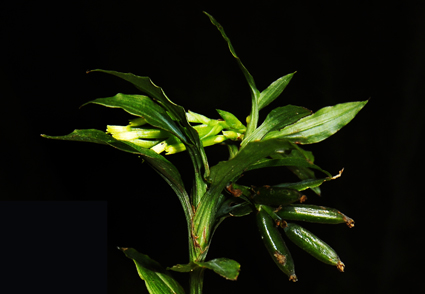Abstract
After examining morphological, molecular and genome-size evidence, we here describe a new orchid species, Apostasia fujianica, from Fujian, China. Morphological comparisons indicated that A. fujianica is similar to A. shenzhenica and A. nipponica, whereas the former displayed distinct differences in habit, roots, leaves, inflorescences and fruit shape and size. Apostasia fujianica (341 Mb) has a smaller genome size than A. shenzhenica (471 Mb), A. ramifera (366 Mb) and A. fogangica (931 Mb). Molecular analyses from combined nuclear (ITS, Xdh, naD1) and plastid (matK, rbcL, psbA-trnH, trnL-trnF and trnS-trnG) datasets indicated that A. fujianica is sister to A. shenzhenica. These results support the status of A. fujianica as a new species, distinguished in many aspects from A. shenzhenica, A. ramifera and A. nipponica.
References
<p>Blume, C.L. (1834) De novis quibusdam plantarum familiis expositio et olim jam expositarum enumeratio. <em>Tijdschrift voor Natuurlijke Geschiedenis en Physiologie</em> 1: 140–142.</p>
<p>Brown, R. (1830) <em>Apostasia</em> Blume.<em> In</em>: Wallich, N. (Eds.) <em>Plantae Asiaticae rariores </em>1. Treuttel and Würtz, London, pp. 74–76.</p>
<p>Chen, C.Q. & Lang, K.Y. (1986) A revision of the orchid subfamily Apostasioideae in China. <em>Acta Phytotaxonomica Sinica</em> 24: 346–352.</p>
<p>Chen, C.Q., Gale, S.W. & Cribb, P.J. (2009) Apostasioideae. <em>In:</em> Wu, Z.G., Raven, P.H. & Hong, D.Y. (Eds.), <em>Flora of China </em>25. Science Press, Beijing, pp. 184–195.</p>
<p>Chen, L.J. & Liu, Z.J. (2011) <em>Apostasia shenzhenica</em>, a new species of Apostasioideae (Orchidaceae) from China. <em>Plant Science Journal</em> 29: 38–41. https://doi.org/10.3724/SP.J.1142.2011.10038</p>
<p>de Vogel, E.F. (1969) Monograph of the tribe Apostasieae (Orchidaceae). <em>Blumea</em> 17: 313–350.</p>
<p>IUCN (2012) <em>IUCN Red List categories and criteria</em>, version 3.1, second edition. Gland and Cambridge, 30 pp.</p>
<p>Jersáková, J., Trávníček, P., Kubatova, B., Krejčíková, J., Urfus, T., Liu, Z.J., Lamb, A., Ponert, J., Schulte, K., Čurn, V., Vrána, J., Leitch, I.J. & Suda, J. (2013) Genome size variation in Orchidaceae subfamily Apostasioideae: filling the phylogenetic gap. <em>Botanical Journal of the Linnean Society</em> 172: 95–105. https://doi.org/10.1111/boj.12027</p>
<p>Kocyan, A. & Endress, P.K. (2001) Floral structure and development of <em>Apostasia</em> and <em>Neuwiedia</em> (Apostasioideae) and their relationships to other Orchidaceae. <em>International Journal of Plant Sciences</em> 162: 847–867. https://doi.org/10.1086/320781</p>
<p>Kumar, P. & Gale, S. (2022) Taxonomic notes on <em>Apostasia nipponica</em> and <em>Crepidium cordilabium</em> (Orchidaceae), two species newly recorded from Hong Kong. <em>Feddes Repertorium</em>: 1–17. https://doi.org/10.1002/fedr.202200002</p>
<p>Li, M.H., Zhang, G.Q., Liu, Z.J. & Lan, S.R. (2014) Revision of <em>Hygrochilus</em> (Orchidaceae: Epidendroideae: Aeridinae) and a molecular phylogenetic analysis. <em>Phytotaxa</em> 159 (4): 256–268. https://doi.org/10.11646/phytotaxa.159.4.2</p>
<p>Li, M.H., Zhang, G.Q., Liu, Z.J. & Lan, S.R. (2016) Subtribal relationships in Cymbidieae (Epidendroideae, Orchidaceae) reveal a new subtribe, Dipodiinae, based on plastid and nuclear coding DNA. <em>Phytotaxa</em> 246 (1): 37–48. https://doi.org/10.11646/phytotaxa.246.1.3</p>
<p>Linnaeus, C. (1753) <em>Species plantarum</em> 2. Salvius, Stockholm, 951 pp.</p>
<p>Liu, Z.J., Chen, L.J., Chen, S.C., Cai, J., Tsai, W.C., Hsiao, Y.Y., Ma, X.Y. & Zhang, G.Q. (2011) <em>Paraholcoglossum</em> and <em>Tsiorchis</em>, two new orchid genera established by molecular and morphological analyses of the <em>Holcoglossum </em>alliance. <em>PLoS ONE</em>: e24864. https://doi.org/10.1371/journal.pone.0024864</p>
<p>Masamune, G. (1935) On the occurrence of <em>Apostastia</em> in Japan. <em>Journal of Japanese Botany</em> 11: 46–47.</p>
<p>Rao, V. (1974) The relationships of the Apostasiaceae on the basis of floral anatomy. <em>Botanical Journal of the Linnean Society</em> 68: 319–327. https://doi.org/10.1111/j.1095-8339.1974.tb01982.x</p>
<p>Rolfe, R.A. (1907) Miscellaneous notes (with figs.). <em>Bulletin of Miscellaneous Information (Royal Botanic Gardens, Kew)</em> 1907: 403–412. https://doi.org/10.2307/4111772</p>
<p>Yin, Y.Y., Zhong, P.S., Zhang, G.Q., Chen, L.J., Zeng, S.J., Li, M.H. & Liu, Z.J. (2016) Morphological, genome-size and molecular analyses of <em>Apostasia fogangica</em> (Apostasioideae, Orchidaceae), a new species from China. <em>Phytotaxa</em> 277 (1): 59–67. https://doi.org/10.11646/phytotaxa.277.1.5</p>
<p>Zhang, G.Q., Liu, K.W., Li, Z., Lohaus, R., Hsiao, Y.Y., Niu, S.C., Wang, J.Y., Lin, Y.C., Xu, Q., Chen, L.J., Yoshida, K., Fujiwara, S., Wang, Z.W., Zhang, Y.Q., Mitsuda, N., Wang, M., Liu, G.H., Pecoraro, L., Huang, H.X., Xiao, X.J., Lin, M., Wu, X.Y., Wu, W.L., Chen, Y.Y., Chang, S.B., Sakamoto, S., Ohme-Takagi, M., Yagi, M., Zeng, S.J., Shen, C.Y., Yeh, C.M., Luo, Y.B., Tsai, W.C., Peer, Y.V. de & Liu, Z.J. (2017) The <em>Apostasia</em> genome and the evolution of orchids. <em>Nature</em> 54: 379–383. https://doi.org/10.1038/nature23897</p>
<p>Zhang, G.Q., Liu, K.W., Chen, L.J., Xiao, X.J., Zhai, J.W., Li, L.Q., Cai, J., Hsiao, Y.Y., Rao, W.H. Huang, J., Ma, X.Y., Chung, S.W., Huang, L.Q., Tsai, W.C. & Liu, Z.J. (2013) A new molecular phylogeny and a new genus, <em>Pendulorchis</em>, of the <em>Aerides-Vanda</em> alliance (Orchidaceae: Epidendroideae). <em>PLoS ONE</em>: e60097. https://doi.org/10.1371/journal.pone.0060097</p>
<p>Zhang, W., Zhang, G., Zeng, P., Zhang, Y., Hu, H., Liu, Z. & Cai, J. (2021) Genome sequence of <em>Apostasia ramifera</em> provides insights into the adaptive evolution in orchids. <em>BMC Genomics</em> 22: 1–12. https://doi.org/10.1186/s12864-021-07852-3</p>


